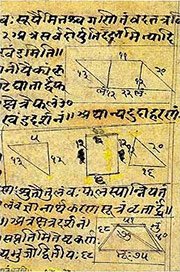Tastha: 1 definition
Introduction:
Tastha means something in Hinduism, Sanskrit. If you want to know the exact meaning, history, etymology or English translation of this term then check out the descriptions on this page. Add your comment or reference to a book if you want to contribute to this summary article.
In Hinduism
Ganitashastra (Mathematics and Algebra)
Source: archive.org: Hindu MathematicsTastha (तस्थ) refers to the “cross multiplication method” and represents one of the various methods of Guṇana (“multiplication”) which represents one of the twenty operations (logistics) of pāṭīgaṇita (“science of calculation which requires the use of writing material—the board”), according to Pṛthudakasvāmī’s commentary on the Brāhmasphuṭasiddhānta by Brahmagupta, a Sanskrit treatise on ancient Indian mathematics (gaṇita-śāstra) and astronomy from the 7th century.—The tastha method is algebraic and has been compared to tiryagguṇana or vajrābhyāsa (cross multiplication) used in algebra.—This method [e.g., tastha] was known to the Hindu scholars of the 8th century, or earlier. The method seems to have traveled to Arabia and thence was transmitted to Europe, where it occurs in Pacioli’s Suma and is stated to be “more fantastic and ingenious than the others”.
Śrīdhara in the Triśatikā: “The next (method) in which (the multiplier) is stationary is the tastha”.
Gaṇeśa in the Gaṇitamañjarī: “That method of multiplication in which the numbers stand in the same place, is called tastha-guṇana. It is as follows: after setting the multiplier under the multiplicand multiply unit by unit and note the result underneath. Then as in vajrābhyāsa multiply unit by ten and ten by unit, add together and set down the result in the line. Next multiply unit by hundred, hundred by unit and ten by ten, add together and set down the result as before; and so on with the rest of the digits. This being done, the line of results is the product”.

Ganitashastra (शिल्पशास्त्र, gaṇitaśāstra) refers to the ancient Indian science of mathematics, algebra, number theory, arithmetic, etc. Closely allied with astronomy, both were commonly taught and studied in universities, even since the 1st millennium BCE. Ganita-shastra also includes ritualistic math-books such as the Shulba-sutras.
See also (Relevant definitions)
Starts with: Tasthana.
Ends with (+36): Abhyutastha, Agatastha, Aikyakutastha, Amritastha, Antastha, Apadantastha, Bhutastha, Cittastha, Ekantastha, Ekapadavratastha, Ekapatnivratastha, Gahvarantastha, Gamgematastha, Ghatastha, Hastastha, Jatastha, Kanyavratastha, Kapatastha, Kartritastha, Kulantastha.
Relevant text
Search found 3 books and stories containing Tastha; (plurals include: Tasthas). You can also click to the full overview containing English textual excerpts. Below are direct links for the most relevant articles:
Rig Veda (translation and commentary) (by H. H. Wilson)
Rig Veda 10.109.3 < [Sukta 109]
The Markandeya Purana (Study) (by Chandamita Bhattacharya)
Division of Varṇa (b): The Kṣatriyas < [Chapter 2]
Yoga-sutras (with Vyasa and Vachaspati Mishra) (by Rama Prasada)
Sūtra 1.41 < [Book 1 - Trance (Samādhi)]